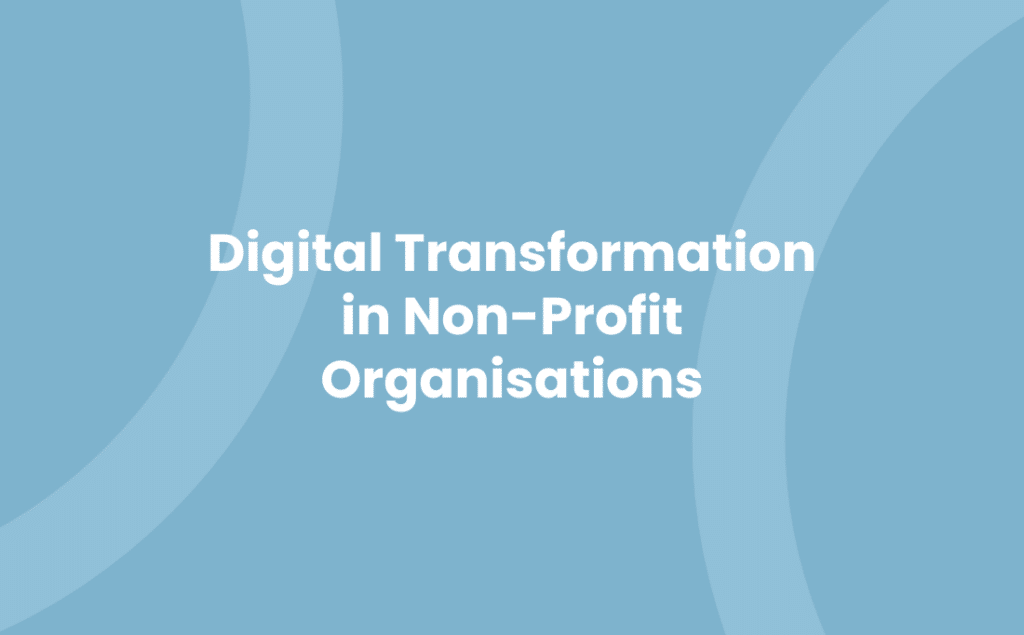In today’s digital age, no sector is left untouched by the wave of digital transformation, including the non-profit realm. It’s a game-changer, offering new opportunities to increase reach, efficiency, and impact. But what does it really mean for non-profit organisations, and how can they navigate this digital landscape?
Understanding Digital Transformation
“Digital Transformation” represents a complete rethinking of how an organisation uses technology, people, and processes to fundamentally change the way it functions. It’s a shift from legacy systems to new, agile business processes. In the context of non-profit organisations, digital transformation can revolutionise the way you engage with donors, volunteers, and beneficiaries.
Two primary components make up digital transformation: digital technology and organisational change. This combinative approach requires an overhaul of an organisation’s traditional processes and consumer interactions, incorporating digital technology. Imagine a blend of streamlined processes, cloud-based services, data analytics, and digital communication tools designed to foster collaboration and communication.
Digital transformation, in essence, enables non-profits to increase their reach, streamline operational procedures, and adapt to the fast-paced digital age. Shifting to digital tools like online donation platforms, social media, and email marketing, for instance, allows non-profits to connect with a wider audience and foster stronger relationships.
Moreover, utilising data analytics gives way to personalised donor communication, substantively boosting donor retention rates. By interpreting data patterns and trends, you can understand your audience’s preferences, tailoring your communication and in turn, improving your fundraising efforts.
On the operations side, digital transformation translates to streamlined procedures and increased efficiency. For example, managing databases, tracking donations, and reporting become less time-consuming when it’s all digitalised, giving teams more time to focus on what really matters – the cause.
Understanding digital transformation is, thus, the first step towards utilising the inherent potential of digitalisation to serve your cause. Embracing these digital strategies within non-profit organisations can lead to more impactful results, even with limited resources. It’s worth noting that it isn’t about replacing the human touch, but enhancing and supporting it. In the volatile world of non-profit organisations, staying ahead of the curve includes evolving digitally.
Digital Transformation in the Non-Profit Sector
Embracing digital transformation within non-profit organisations presents avenues for innovation. You tap into numerous benefits such as automation, collaboration, and data analysis, key aspects that condition the organisation’s success. In particular, digital transformation in a non-profit context refers to incorporating digital technology in all areas, fundamentally changing how you operate and deliver value to your beneficiaries.
Adopt digital strategies and observe a transformational shift in your operations, it’s essential considering the exponential growth of digital technology. For example, implementing cloud solutions allows you to access and share information seamlessly. Moreover, with automation tools, routine tasks like scheduling, reporting, and accounting become a breeze, saving valuable time and resources.
Inclusion of data analytics in your organisation’s framework enhances your decision-making process. You obtain accurate insights into donor behaviours, preferences, and engagement levels, this information guides strategic planning and fundraising initiatives.
Furthermore, digital transformation in non-profit settings aims at bettering external communication. You achieve this through social media platforms and personalised email marketing, fostering a direct connection with your audience. Now, sharing compelling stories about your initiatives, celebrating successes, and expressing gratitude to donors is simpler and more impactful.
Investing in cyber-security measures is also a part of the digital transformation. As a non-profit, you handle sensitive data that, if breached, could severely harm your reputation. Hence, employing robust security measures keep your organisation digitally safe and your stakeholders confident in your cause.
In a rapidly digitising world, no sector remains untouched by digital transformation, and non-profits are no exception. By embracing digital strategies and leveraging technology, your non-profit organisation becomes more efficient, more transparent, and more connected. As we move forward, the digital transformation of non-profit organisations isn’t only beneficial but vital to their survival. This transformation statistics, trends and insights will be a critical consideration for non-profits aiming to achieve substantial impact.
How Non-Profit Organisations are Embracing Digital Transformation
Embracing digital transformation in non-profit organisations has seen the sector leap, not crawl, into the 21st century. Success stories brim from organisations, large and small, who’ve successfully adopted digital strategies.
The use of cutting-edge technology platforms proves invaluable for non-profits as it helps them streamline operational processes. For instance, Customer Relationship Management (CRM) systems act as a one-stop solution, aiding in contact management, volunteer coordination, and donor tracking. Simultaneously, cloud-based software solutions present opportunities for remote work, enabling quick and secure information sharing. Thus, digital transformation for non-profit entities is no longer a choice; it’s a necessity.
Digital fundraising has also become a critical aspect underpinning the success of non-profit organisations. Online fundraising platforms and mobile apps have drastically improved the way organisations reach out to potential donors. GivingTuesday, a global day of giving, demonstrated this effectively by raising $2.47 billion in the U.S alone, with 34.8 million people participating via online platforms.
Social media plays a pivotal role in driving the digital transformation narrative for non-profits. Channels such as Facebook, Twitter and Instagram, when used effectively, empower these organisations to connect with their audience on a more personal level. These platforms aren’t just limited to sharing updates; they also provide a medium for advocacy and volunteer recruitment.
Furthermore, non-profit organisations have seen substantial benefits from data-analytics. By leveraging large data sets, these entities have the capacity to derive insights for decision-making processes. This data-driven approach not only increases transparency but also improves strategic planning, allowing for the highest level of effectiveness when running campaigns or allocating resources.
Lastly, embracing digital transformation includes prioritising digital security. Non-profit organisations have started to realise the significance of cyber-security measures and are implementing stringent protocols to safeguard sensitive information.
Clearly, the trend of digital transformation in non-profit organisations lends itself to improved connectivity, efficiency and overall effectiveness. Despite challenges, these entities embrace change, soldiering on in their mission, ensuring their survival and maintaining a profound impact amidst rapid digitalisation in every quarter.
Case Studies of Digital Transformation in Non-Profit Organisations
Dive into detailed accounts of how digital transformation has made significant strides in several non-profit organisations.
- United Nations Children’s Fund (UNICEF) adopted a digital approach to amplify its anti-child labour campaign. Leveraging the power of social media channels, the organisation managed to reach millions globally. Data analytics offered insights to shape the campaign’s direction, resulting in a remarkable increase in support and donations.
- American Cancer Society (ACS), facing a stagnation in donations, embarked on an impressive digital transformation journey. Through modernising their website and incorporating a digital fundraising platform, the increase in accessibility led to a significant surge in donations. Mobile applications enhanced donor engagement, showcasing a shining example of a successful non-profit digital strategy.
- British Red Cross harnessed the power of digital transformation to enrich their disaster response efforts. By pioneering the use of cloud-based solutions, they streamlined operations and improved response times. Their digital transition demonstrated the agility and efficiency non-profit organisations can gain through embracing digital technology.
- WWF’s virtual reality app, launched in partnership with Google, leverages technology to provide a captivating insight into the life of wild animals, thereby raising awareness about conserving their natural habitats. Through this initiative, WWF astutely combined digital transformation with their advocacy efforts.
- UK’s non-profit Age UK brilliantly optimised the use of CRM systems. By centralising donor interactions and integrating these with their email marketing, they boosted donor relations significantly. It’s testament to how digital transformation can improve non-profit operational efficiency.
- Non-profit Tech for Good, though not a traditional non-profit, provides critical digital training and resources to non-profit leaders and organisations across the globe. Through their innovative use of technology, they’re amplifying the effects of digital transformation within the non-profit sector.
These instances illustrate the incredible potential and profound impact of digital transformation within non-profit organisations. Your organisation, too, can harness this power, enabling progressiveness, efficiency, and meaningful engagement with your audience.
Planning Digital Transformation in Your Non-Profit Organisation
To embark on your digital transformation path, a strategic approach is pivotal. Develop a clear vision for integrating sophisticated technology. Allow us to explore the essential steps that’ll guide your successful digital evolution in the non-profit arena.
1. Assess Current Digital Maturity: It’s imperative to understand your current digital standings. Assess technology proficiency, data use, and digital skills available within your organisation, unveiling areas for advancement.
As an example, Amnesty International evaluated their current digital systems. They identified inefficiencies such as using outdated software, leading to their decision to upgrade their digital infrastructure, resulting in improved operations.
2. Set Clear Goals: With a comprehension of your digital standing, formulate explicit goals. Your goals may include increased donor engagement or improved fundraising strategies through technological advancements.
3. Devise a Digital Strategy: Use your goals to build a well-defined digital strategy. It usually comprises new technology implementation, staff training, and data management practices. An effective strategy aligns with your non-profit aims while considering your target audience’s digital behaviour.
For instance, UNICEF’s Anti-child labour campaign thrived by incorporating social media and data analytics. These tools are parts of their digital strategy, which led to their campaign’s success.
4. Secure Necessary Investments: Technology and training require considerable investments. Develop a budget that caters for these new investments, anticipating future operational costs as well. Non-profits like Age UK found success in donor relations upon implementing CRM systems‚Äö an investment that indeed proved beneficial.
5. Implement and Monitor: Deploy your chosen technologies and monitor the impact. Constantly review your strategies, adapting to evolving technological trends. This approach was exemplified by ACS’s website modernisation, which led to increased donations. Their continuous tracking and tweaking, to keep up with the digital landscape, bears testament to the importance of implementation and observance.
Innovative applications, such as WWF’s virtual reality app, show the potential of unique, high-impact digital strategies. However, embracing a change of this magnitude calls for careful planning and sustained efforts. With the right strategy in place, your charity can harness the power of digital transformation. Flexibility, adaptability, and a strategic digital roadmap are integral to your non-profit’s successful digital makeover.
Conclusion
Digital transformation isn’t just a buzzword. It’s a game-changer for non-profit organisations. By embracing technology, you’re not only keeping pace with the digital world, but you’re also opening doors to increased engagement, improved fundraising, and enhanced data-driven decision making. Remember, it’s not about jumping on the latest tech bandwagon. It’s about careful planning, setting clear goals, and creating a robust digital strategy. From UNICEF’s social media campaigns to Amnesty International’s system upgrade, the success stories are out there. So, it’s time to assess your digital maturity and start your journey towards a successful digital transformation. It’s your move. Make it a smart one.


